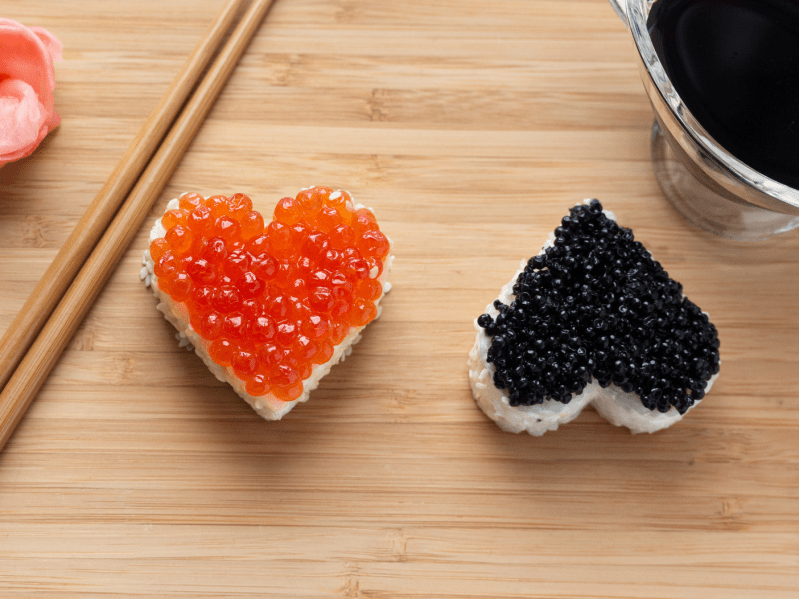If you’ve eaten sushi or sashimi in your lifetime, you’ve probably tasted different types of roe—or fish eggs—whether you knew it or not. With their bright and vivid colors, crunchy ‘pop’-like texture, and salty flavor, roe is often used to enhance or garnish sushi rolls and other Japanese dishes. It is even sometimes used as the main ingredient or “star” of the dish as well.
Videos by Suggest
There are many varieties and types of roe out there, including caviar (sturgeon eggs) and ikura (salmon eggs), however, tobiko and masago are the most common. Often confused with one another, tobiko and masago share similarities but also have notable differences and benefits. Let’s take a closer look at these two delectable sushi roe varieties and what makes them different.
What Is Tobiko Roe?

Tobiko is the fish eggs (roe) from flying fish—generally from a tropical climate. This type of roe tends to be quite small in size, ranging anywhere from 0.5 mm to 0.8 mm. In its natural state, tobiko is reddish-orange in color and often very vibrant and bright. When you’re shopping for tobiko, however, you might find tobiko in a wide range of colors. Markets and purveyors will sometimes dye tobiko black using squid ink, green using wasabi, yellow using yuzu, or red using beets. As for flavor, tobiko tends to carry a smoky and salty taste but holds a bit of sweetness as well.
Tobiko also carries specific health benefits, making it a great addition to your diet. It’s high in protein, rich in omega-3 fatty acids, and is high in phospholipid fat which helps protect the liver, heart, improve cognition, and reduce inflammation. On the flip side, tobiko is also extremely high in cholesterol, so consumption in moderation is key. Tobiko is often served in very small portions so overindulgence isn’t usually a concern—usually served as a garnish, on top of rolls, or even as sashimi accompanied with avocado.
What Is Masago Roe?

Masago roe comes from the capelin fish—a fish in the smelt family, often found in the North Atlantic, North Pacific, and Arctic Oceans. These tiny fish produce very small eggs which are even smaller than tobiko roe, giving them a different, more delicate texture. In fact, it’s one of the smallest size roe, and it’s often referred to as masa—or sand—because it can be sand-like in texture. Masago is also a reddish-orange (sometimes even yellow) but doesn’t tend to give off a vibrant hue, it sits on a “duller” side. Masago’s flavor is salty with a punch of bitterness, making it more of a garnish than the focus of a roll or served as sashimi.
Masago too has many health benefits when it’s consumed. A 28-gram serving has as much as 6 grams of protein, it’s rich in selenium (a powerful cancer-fighting antioxidant), vitamin B-12, omega-3 fatty acids, and it also has a low mercury count compared to many forage fish like the capelin. Some disadvantages to consuming masago roe are that it is high in sodium (up to ten percent of your daily value in just one tablespoon), and there are some moral objections as to how consumption might affect the connected food chain. In fact, the Department of Fisheries and Oceans recently reported that the capelin population had declined by 70 percent between 2015 and 2018, although it’s thought to be due more to environmental issues than over-fishing.
Tobiko Vs. Masago

The novice sushi lover might find it hard to distinguish between tobiko and masago, as they do have many similarities. However, if you know a few distinctions, you can tell the difference between the two. Overall, masago is the smaller roe type between them. It’s also less vibrant and colorful than tobiko. Tobiko is brighter, saltier, and even crunchier than masago roe.
Tobiko tends to have a more intense flavor than masago, but it’s not overpowering. This is why you can usually swap tobiko for masago in many situations, but it’s also used as the main feature or as a filling. Sushi chefs will also often choose tobiko over masago to use for Gunkan nigiri. If you happen to be a person that enjoys sushi without anything tasting too “fishy,” masago will probably be your go-to. It’s not too potent in flavor or smell.
Another difference between the two popular types of roe is that masago tends to be much cheaper than tobiko. That’s why you’ll generally see masago in restaurants more often than tobiko—even though many restaurants will claim they have “flying fish” roe. Both types of fish roe can generally be found at any Asian or Japanese market that sells frozen or fresh fish. At these markets, you can sometimes find raw, fresh tobiko or masago in small cups in the seafood section or frozen in large batches. If an authentic Asian market isn’t available, larger grocery chains and online retailers sell both types.
When eaten in moderation, tobiko and masago can be a very healthy addition to your diet. Keep an eye out the next time you dine out for sushi or make your own at home—you can compare and contrast for yourself to see which type of roe tastes best to you.
